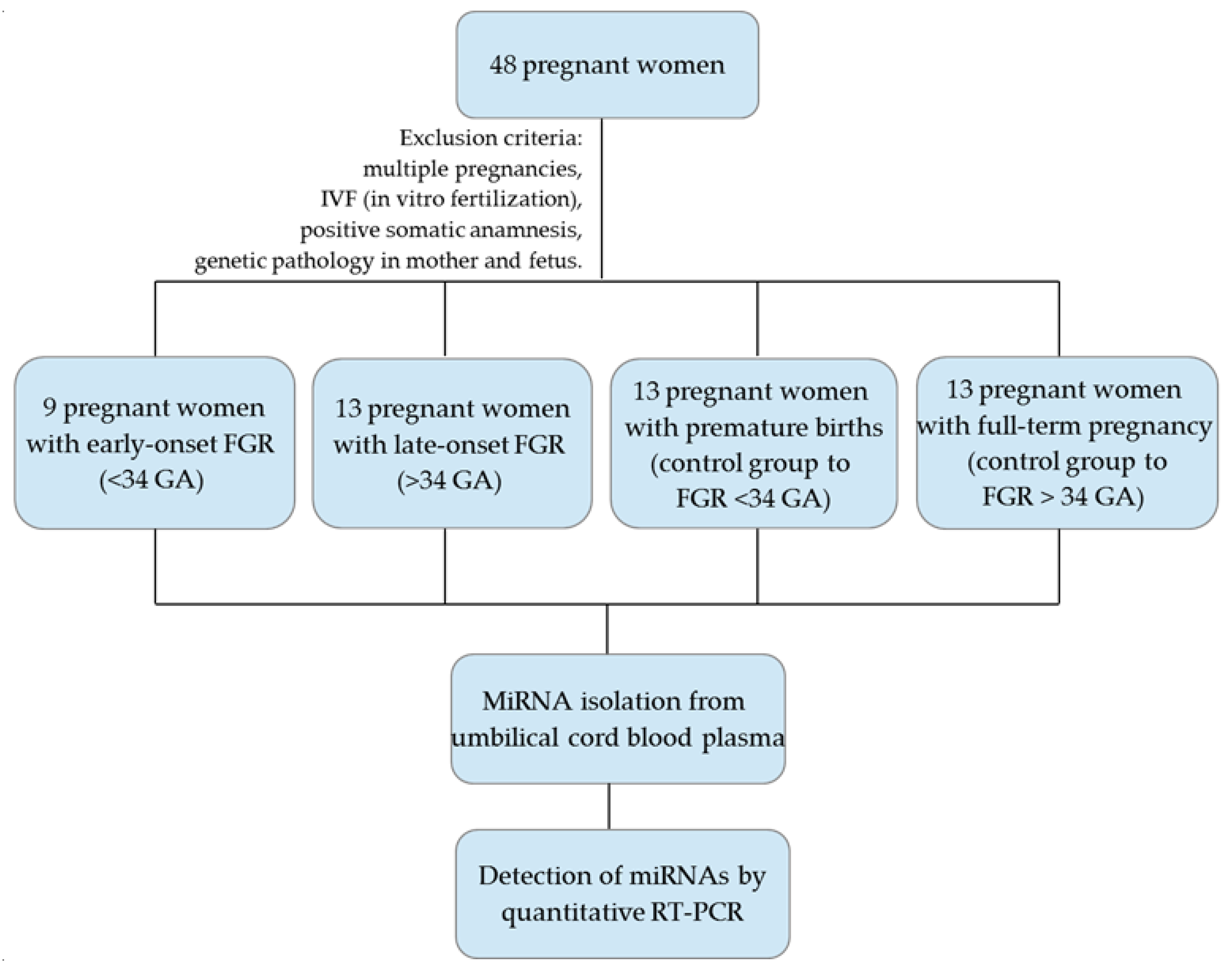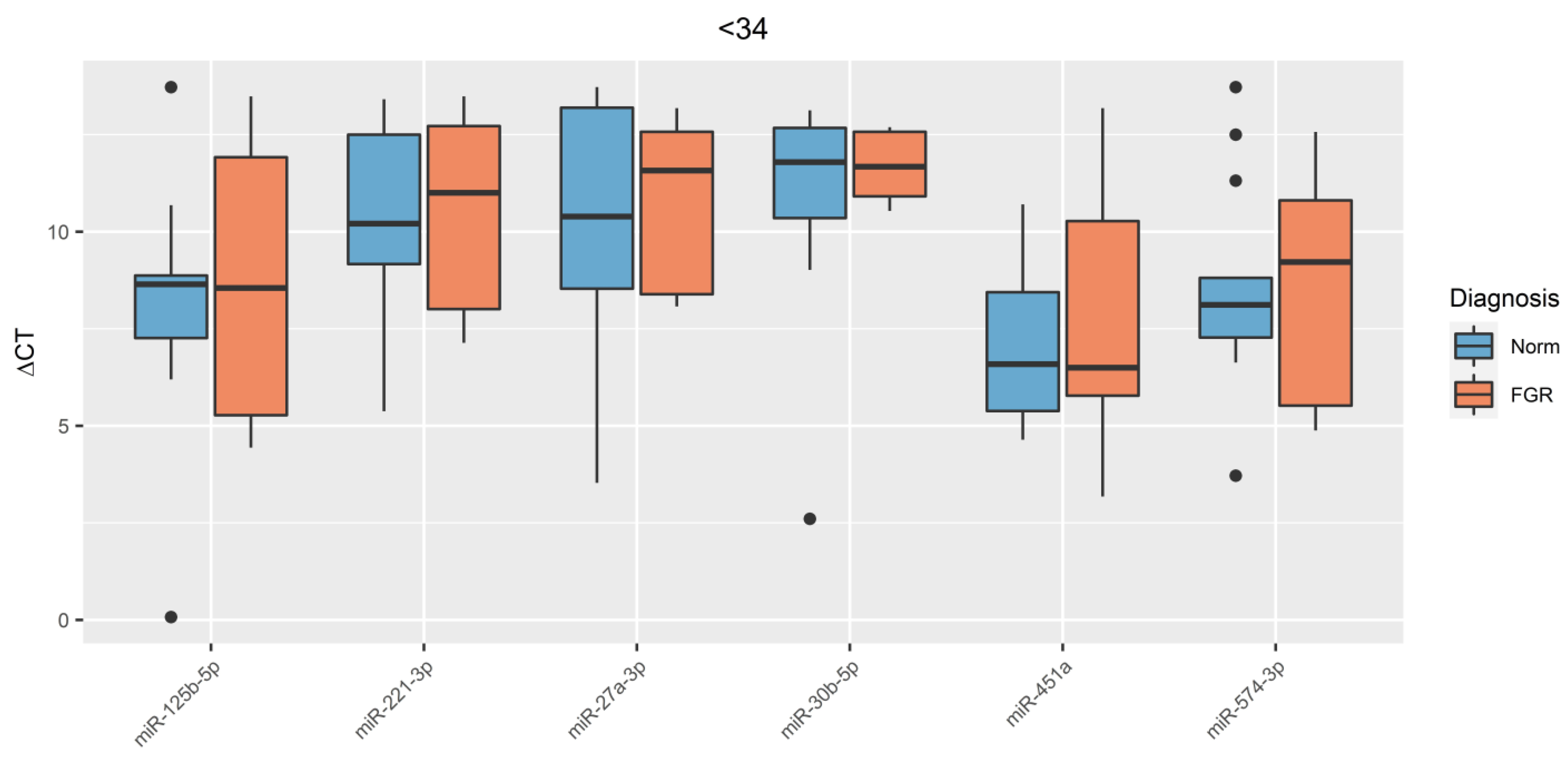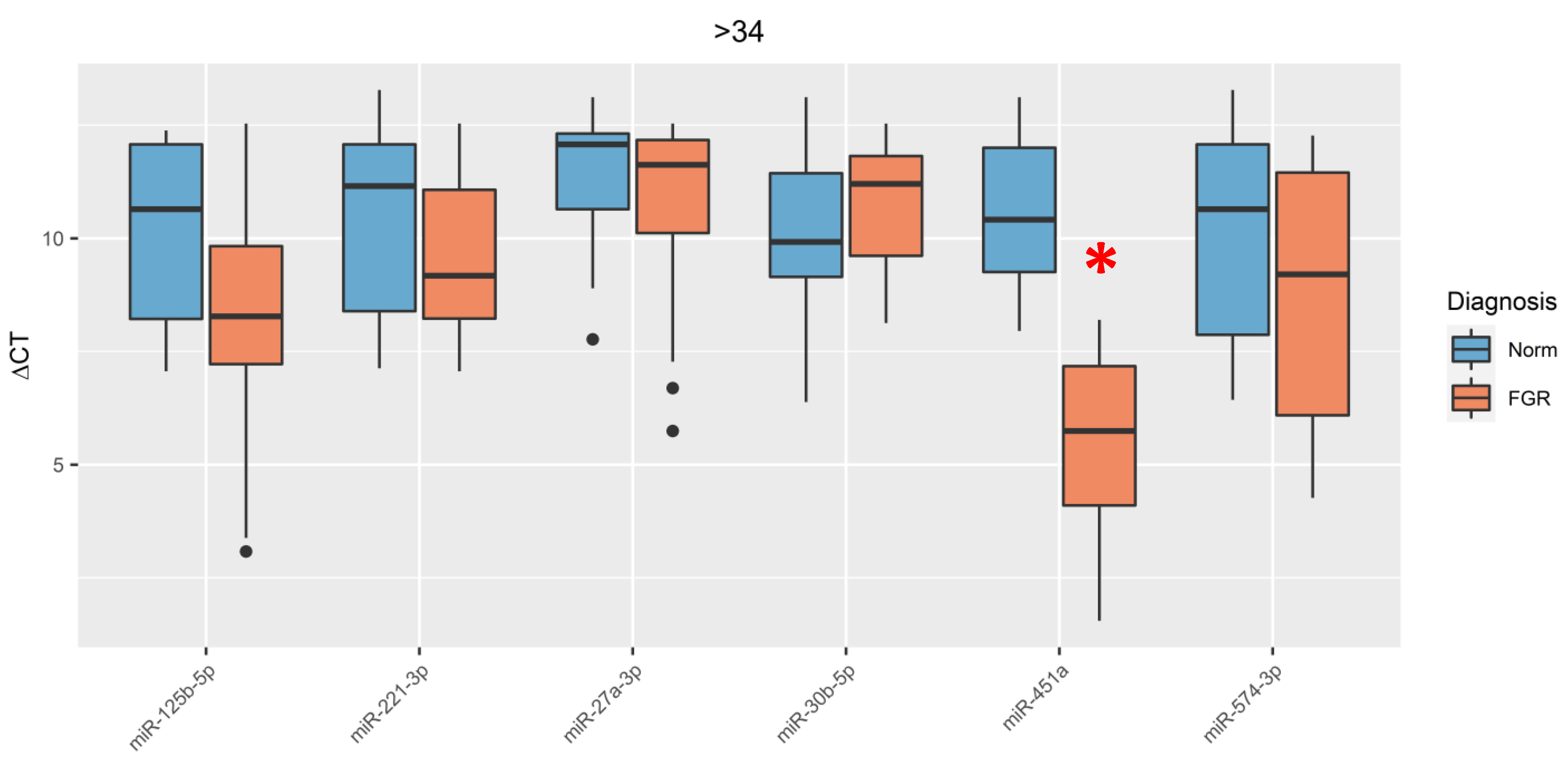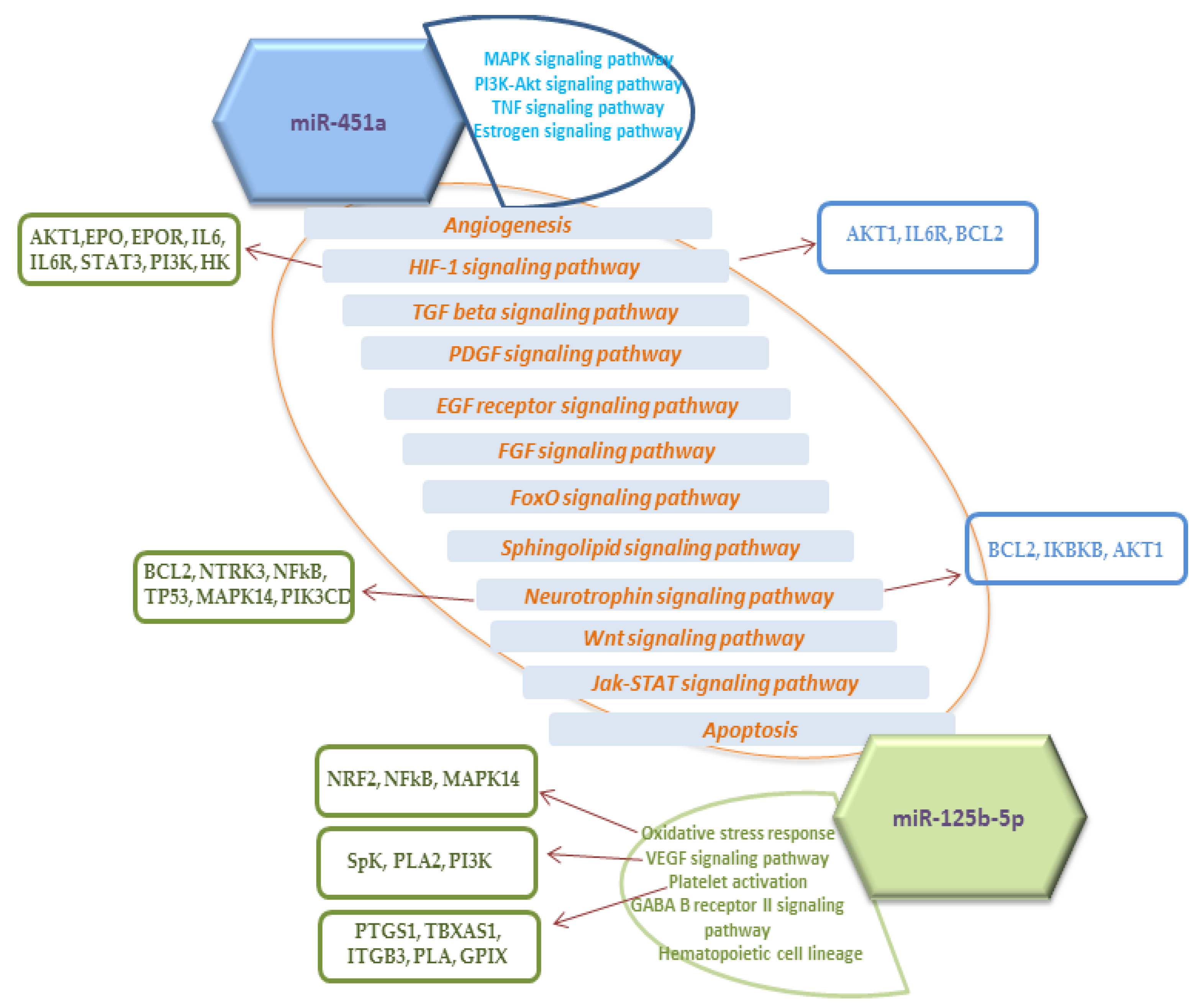MiRNAs Regulating Oxidative Stress: A Correlation with Doppler Sonography of Uteroplacental Complex and Clinical State Assessments of Newborns in Fetal Growth Restriction
Abstract
1. Introduction
2. Materials and Methods
2.1. Study Design and Patient Cohort
2.2. Clinical Data, Ultrasound and Doppler Sonography Measurement
2.3. Clinical State Assessment of Newborns and Neonatal Outcomes
2.4. Blood Collection and miRNA Isolation from Umbilical Cord Blood Plasma
2.5. Real-Time Quantitative RT-PCR
2.6. Statistical Data Analysis
3. Results
3.1. Evaluation of miRNAs Regulating Oxidative Stress Expression in Umbilical Cord Blood Plasma
3.2. Correlation of miRNA Expression in Umbilical Cord Blood with Doppler Measurement of Pregnant Women and Clinical State Assessment of Newborns with FGR
3.3. Correlation of miRNA Expression in Placenta with Doppler Measurement of Pregnant Women and Clinical State Assessment of Newborns with FGR
3.4. Correlation of Doppler Measurement of Pregnant Women with Clinical State Assessment of Newborns with FGR
4. Discussion
5. Conclusions
Supplementary Materials
Author Contributions
Funding
Conflicts of Interest
References
- Nardozza, L.M.M.; Caetano, A.C.R.; Zamarian, A.C.P.; Mazzola, J.B.; Silva, C.P.; Marçal, V.M.G.; Lobo, T.F.; Peixoto, A.B.; Araujo Júnior, E. Fetal growth restriction: Current knowledge. Arch. Gynecol. Obstet. 2017, 295, 1061–1077. [Google Scholar] [CrossRef]
- American College of Obstetricians and Gynecologists. ACOG Practice Bulletin No. 204: Fetal Growth Restriction. Obstet. Gynecol. 2019, 133, e97–e109. [Google Scholar] [CrossRef]
- Visentin, S.; Grumolato, F.; Nardelli, G.B.; Di Camillo, B.; Grisan, E.; Cosmi, E. Early origins of adult disease: Low birth weight and vascular remodeling. Atherosclerosis 2014, 237, 391–399. [Google Scholar] [CrossRef]
- Yzydorczyk, C.; Armengaud, J.B.; Peyter, A.C.; Chehade, H.; Cachat, F.; Juvet, C.; Siddeek, B.; Simoncini, S.; Sabatier, F.; Dignat-George, F.; et al. Endothelial dysfunction in individuals born after fetal growth restriction: Cardiovascular and renal consequences and preventive approaches. J. Dev. Orig. Health Dis. 2017, 8, 448–464. [Google Scholar] [CrossRef]
- Hung, T.-H.; Skepper, J.N.; Burton, G.J. In Vitro Ischemia-Reperfusion Injury in Term Human Placenta as a Model for Oxidative Stress in Pathological Pregnancies. Am. J. Pathol. 2001, 159, 1031–1043. [Google Scholar] [CrossRef]
- Takagi, Y.; Nikaido, T.; Toki, T.; Kita, N.; Kanai, M.; Ashida, T.; Ohira, S.; Konishi, I. Levels of oxidative stress and redox-related molecules in the placenta in preeclampsia and fetal growth restriction. Virchows Arch. 2004, 444, 49–55. [Google Scholar] [CrossRef]
- Krause, B.J.; Peñaloza, E.; Candia, A.; Cañas, D.; Hernández, C.; Arenas, G.A.; Peralta-Scholz, M.J.; Valenzuela, R.; García-Herrera, C.; Herrera, E.A. Adult vascular dysfunction in foetal growth-restricted guinea-pigs is associated with a neonate-adult switching in Nos3 DNA methylation. Acta Physiol. 2019, 227. [Google Scholar] [CrossRef]
- Hecher, K.; Bilardo, C.M.; Stigter, R.H.; Ville, Y.; Hackelöer, B.J.; Kok, H.J.; Senat, M.V.; Visser, G.H.A. Monitoring of fetuses with intrauterine growth restriction: A longitudinal study: Longitudinal fetal monitoring. Ultrasound Obstet. Gynecol. 2001, 18, 564–570. [Google Scholar] [CrossRef]
- Maisonneuve, E.; Delvin, E.; Ouellet, A.; Morin, L.; Dubé, J.; Boucoiran, I.; Moutquin, J.-M.; Fouron, J.-C.; Klam, S.; Levy, E.; et al. Oxidative conditions prevail in severe IUGR with vascular disease and Doppler anomalies. J. Matern. Fetal Neonatal Med. 2015, 28, 1471–1475. [Google Scholar] [CrossRef]
- Sadovsky, Y.; Mouillet, J.-F.; Ouyang, Y.; Bayer, A.; Coyne, C.B. The Function of TrophomiRs and Other MicroRNAs in the Human Placenta. Cold Spring Harb. Perspect. Med. 2015, 5, a023036. [Google Scholar] [CrossRef]
- Bertero, T.; Rezzonico, R.; Pottier, N.; Mari, B. Impact of MicroRNAs in the Cellular Response to Hypoxia. In International Review of Cell and Molecular Biology; Elsevier: Amsterdam, The Netherlands, 2017; Volume 333, pp. 91–158. ISBN 978-0-12-811870-2. [Google Scholar]
- Engedal, N.; Žerovnik, E.; Rudov, A.; Galli, F.; Olivieri, F.; Procopio, A.D.; Rippo, M.R.; Monsurrò, V.; Betti, M.; Albertini, M.C. From Oxidative Stress Damage to Pathways, Networks, and Autophagy via MicroRNAs. Oxidative Med. Cell. Longev. 2018, 2018, 4968321. [Google Scholar] [CrossRef] [PubMed]
- Rudov, A.; Balduini, W.; Carloni, S.; Perrone, S.; Buonocore, G.; Albertini, M.C. Involvement of miRNAs in Placental Alterations Mediated by Oxidative Stress. Oxidative Med. Cell. Longev. 2014, 2014, 103068. [Google Scholar] [CrossRef] [PubMed]
- Hromadnikova, I.; Kotlabova, K.; Ivankova, K.; Vedmetskaya, Y.; Krofta, L. Profiling of cardiovascular and cerebrovascular disease associated microRNA expression in umbilical cord blood in gestational hypertension, preeclampsia and fetal growth restriction. Int. J. Cardiol. 2017, 249, 402–409. [Google Scholar] [CrossRef] [PubMed]
- Luo, J.; Fan, Y.; Shen, L.; Niu, L.; Zhao, Y.; Jiang, D.; Zhu, L.; Jiang, A.; Tang, Q.; Ma, J.; et al. The Pro-angiogenesis Of Exosomes Derived From Umbilical Cord Blood Of Intrauterine Growth Restriction Pigs Was Repressed Associated With MiRNAs. Int. J. Biol. Sci. 2018, 14, 1426–1436. [Google Scholar] [CrossRef]
- Meng, M.; Cheng, Y.K.Y.; Wu, L.; Chaemsaithong, P.; Leung, M.B.W.; Chim, S.S.C.; Sahota, D.S.; Li, W.; Poon, L.C.Y.; Wang, C.C.; et al. Whole genome miRNA profiling revealed miR-199a as potential placental pathogenesis of selective fetal growth restriction in monochorionic twin pregnancies. Placenta 2020, 92, 44–53. [Google Scholar] [CrossRef]
- Gusar, V.A.; Timofeeva, A.V.; Kan, N.E.; Chagovets, V.V.; Ganichkina, G.M.B.; Frankevich, V.E. The expression profile of placental microRNAs as regulators of oxidative stress in fetal growth restriction. Akusherstvo I Ginekol. 2019, 74–80. [Google Scholar] [CrossRef]
- Gómez, O.; Figueras, F.; Fernández, S.; Bennasar, M.; Martínez, J.M.; Puerto, B.; Gratacós, E. Reference ranges for uterine artery mean pulsatility index at 11-41 weeks of gestation. Ultrasound Obstet. Gynecol. 2008, 32, 128–132. [Google Scholar] [CrossRef]
- Parra-Cordero, M.; Lees, C.; Missfelder-Lobos, H.; Seed, P.; Harris, C. Fetal arterial and venous Doppler pulsatility index and time averaged velocity ranges. Prenat. Diagn. 2007, 27, 1251–1257. [Google Scholar] [CrossRef]
- Demidov, V.N.; Rosenfeld, B.E.; Sigizbaeva, I.K. The importance of the simultaneous use of automated cardiotocography and ultrasound dopplerometry to assess of the fetus state during pregnancy. Sonoace Int. 2001, 9, 73–80. [Google Scholar]
- Malin, G.L.; Morris, R.K.; Khan, K.S. Strength of association between umbilical cord pH and perinatal and long term outcomes: Systematic review and meta-analysis. BMJ 2010, 340, c1471. [Google Scholar] [CrossRef]
- Helwig, J.T.; Parer, J.T.; Kilpatrick, S.J.; Laros, R.K. Umbilical cord blood acid-base state: What is normal? Am. J. Obstet. Gynecol. 1996, 174, 1807–1814. [Google Scholar] [CrossRef]
- Livak, K.J.; Schmittgen, T.D. Analysis of Relative Gene Expression Data Using Real-Time Quantitative PCR and the 2−ΔΔCT Method. Methods 2001, 25, 402–408. [Google Scholar] [CrossRef] [PubMed]
- Aouache, R.; Biquard, L.; Vaiman, D.; Miralles, F. Oxidative Stress in Preeclampsia and Placental Diseases. Int. J. Mol. Sci. 2018, 19, 1496. [Google Scholar] [CrossRef] [PubMed]
- Rodríguez-Rodríguez, P.; Ramiro-Cortijo, D.; Reyes-Hernández, C.G.; López de Pablo, A.L.; González, M.C.; Arribas, S.M. Implication of Oxidative Stress in Fetal Programming of Cardiovascular Disease. Front. Physiol. 2018, 9. [Google Scholar] [CrossRef] [PubMed]
- Herrera, E.A.; Krause, B.; Ebensperger, G.; Reyes, R.V.; Casanello, P.; Parra-Cordero, M.; Llanos, A.J. The placental pursuit for an adequate oxidant balance between the mother and the fetus. Front. Pharmacol. 2014, 5. [Google Scholar] [CrossRef]
- Bilardo, C.M.; Wolf, H.; Stigter, R.H.; Ville, Y.; Baez, E.; Visser, G.H.A.; Hecher, K. Relationship between monitoring parameters and perinatal outcome in severe, early intrauterine growth restriction: Fetal monitoring in IUGR. Ultrasound Obstet. Gynecol. 2004, 23, 119–125. [Google Scholar] [CrossRef]
- Hracsko, Z.; Orvos, H.; Novak, Z.; Pal, A.; Varga, I.S. Evaluation of oxidative stress markers in neonates with intra-uterine growth retardation. Redox Rep. 2008, 13, 11–16. [Google Scholar] [CrossRef] [PubMed]
- Ebbing, C.; Rasmussen, S.; Kiserud, T. Middle cerebral artery blood flow velocities and pulsatility index and the cerebroplacental pulsatility ratio: Longitudinal reference ranges and terms for serial measurements. Ultrasound Obstet. Gynecol. 2007, 30, 287–296. [Google Scholar] [CrossRef]
- Jugović, D.; Tumbri, J.; Medić, M.; Jukić, M.K.; Kurjak, A.; Arbeille, P.; Salihagić-Kadić, A. New Doppler index for prediction of perinatal brain damage in growth-restricted and hypoxic fetuses. Ultrasound Obstet. Gynecol. 2007, 30, 303–311. [Google Scholar] [CrossRef]
- Polglase, G.R.; Allison, B.J.; Coia, E.; Li, A.; Jenkin, G.; Malhotra, A.; Sehgal, A.; Kluckow, M.; Gill, A.W.; Hooper, S.B.; et al. Altered cardiovascular function at birth in growth-restricted preterm lambs. Pediatr. Res. 2016, 80, 538–546. [Google Scholar] [CrossRef]
- Suzuki, S.; Tateoka, S.; Yagi, S.; Ishikawa, G.; Ohshita, T.; Sawa, R.; Yoneyama, Y.; Asakura, H.; Araki, T. Fetal Circulatory Responses to Maternal Blood Loss. Gynecol. Obstet. Investig. 2001, 51, 157–159. [Google Scholar] [CrossRef] [PubMed]
- Tanis, J.C.; Boelen, M.R.; Schmitz, D.M.; Casarella, L.; van der Laan, M.E.; Bos, A.F.; Bilardo, C.M. Correlation between Doppler flow patterns in growth-restricted fetuses and neonatal circulation: Doppler and NIRS in FGR. Ultrasound Obstet. Gynecol. 2016, 48, 210–216. [Google Scholar] [CrossRef] [PubMed]
- Baschat, A.A.; Kush, M.; Berg, C.; Gembruch, U.; Nicolaides, K.H.; Harman, C.R.; Turan, O.M. Hematologic profile of neonates with growth restriction is associated with rate and degree of prenatal Doppler deterioration: Hematologic and Doppler deterioration in FGR. Ultrasound Obstet. Gynecol. 2013, 41, 66–72. [Google Scholar] [CrossRef] [PubMed]
- Martinelli, S.; Francisco, R.P.V.; Bittar, R.E.; Zugaib, M. Hematological indices at birth in relation to arterial and venous Doppler in small-for-gestational-age fetuses. Acta Obstet. Et Gynecol. Scand. 2009, 88, 888–893. [Google Scholar] [CrossRef]
- Tiedt, S.; Prestel, M.; Malik, R.; Schieferdecker, N.; Duering, M.; Kautzky, V.; Stoycheva, I.; Böck, J.; Northoff, B.H.; Klein, M.; et al. RNA-Seq Identifies Circulating miR-125a-5p, miR-125b-5p, and miR-143-3p as Potential Biomarkers for Acute Ischemic Stroke. Circ. Res. 2017, 121, 970–980. [Google Scholar] [CrossRef]
- Liu, G.; Cao, C.; Zhu, M. Peripheral Blood miR-451 May Serve as a Biomarker of Ischemic Stroke. Clin. Lab. 2019, 65. [Google Scholar] [CrossRef]
- Chistiakov, D.A.; Orekhov, A.N.; Bobryshev, Y.V. Extracellular vesicles and atherosclerotic disease. Cell. Mol. Life Sci. 2015, 72, 2697–2708. [Google Scholar] [CrossRef]
- Lawson, C.; Vicencio, J.M.; Yellon, D.M.; Davidson, S.M. Microvesicles and exosomes: New players in metabolic and cardiovascular disease. J. Endocrinol. 2016, 228, R57–R71. [Google Scholar] [CrossRef]
- Escudero, C.A.; Herlitz, K.; Troncoso, F.; Acurio, J.; Aguayo, C.; Roberts, J.M.; Truong, G.; Duncombe, G.; Rice, G.; Salomon, C. Role of Extracellular Vesicles and microRNAs on Dysfunctional Angiogenesis during Preeclamptic Pregnancies. Front. Physiol. 2016, 7. [Google Scholar] [CrossRef]
- Huang, H.; Zhu, J.; Fan, L.; Lin, Q.; Fu, D.; Wei, B.; Wei, S. MicroRNA Profiling of Exosomes Derived from Red Blood Cell Units: Implications in Transfusion-Related Immunomodulation. BioMed Res. Int. 2019, 2019, 1–10. [Google Scholar] [CrossRef]
- Ouyang, Y.; Mouillet, J.-F.; Coyne, C.B.; Sadovsky, Y. Review: Placenta-specific microRNAs in exosomes—Good things come in nano-packages. Placenta 2014, 35, S69–S73. [Google Scholar] [CrossRef] [PubMed]




| <34 GA | >34 GA | |||||
|---|---|---|---|---|---|---|
| Pregnant Women Cohort with FGR (Fetal Growth Restriction) (n = 9) | Control Groups (n = 13) | p-Value | Pregnant Women Cohort with FGR (n = 13) | Control Groups (n = 13) | p-Value | |
| Gestational age at the time of delivery, weeks | 30.5 ± 1.9 | 31.5 ± 1.9 | 0.24 | 37 (36.3–38.3) | 38.2 (36.4–38.5) | 0.31 |
| Maternal age | 33.2 ± 2.9 | 32 ± 4.8 | 0.49 | 32.4 (32–34) | 30.67 (30.67–30.67) | 0.007 |
| Preeclampsia, n (%) | 5 (55.6) | 0 (0) | 0.005 | 2 (15.4) | 0 (0) | 0.49 |
| Ratio of placental dysfunction markers (sFLT-1/PGF; 1,5–7) | 362.3 ± 297.6 | NA | – | 67 ± 31 | NA | – |
| ‡ Pulsatility index of Uterine Artery (PI UtA.) [18] | 2.24 ± 1.25 | −0.11 ± 0.44 | <0.001 | 0.41 (0.11–1.31) | 0.38 (0.18–0.42) | 0.52 |
| ‡ Pulsatility index of Umbilical Artery (PI UA) [19] | 3.12 ± 1.43 | −0.28 ± 0.44 | <0.001 | 0.75 (0.19 – 0.96) | 0 (−0.12–0.19) | 0.008 |
| ‡ Pulsatility index of Middle Cerebral Artery (PI MCA) [19] | −0.56 ± 0.72 | −0.12 ± 0.4 | 0.12 | −0.43 (−0.68–0.36) | 0.57 (0.24–0.68) | 0.05 |
| Cerebral Placental Ratio (CPR > 1) | 0.94 ± 0.16 | 2.33 ± 0.44 | <0.001 | 1.45 (1–2.08) | 2.11 (2.08–2.21) | 0.02 |
| Estimated Fetal Weight, ultra-sonography (EFW) | 949 (922–1000) | 1734 (1555–2160) | 0.005 | 2136 (1835–2465) | 3310.6 (3096–3548) | <0.001 |
| Impaired fetoplacental and uteroplacental blood flow, n (%) | 9 (100) | 0 (0) | <0.001 | 7 (53.8) | 0 (0) | 0.003 |
| IFC (indicator of fetal condition) (CTG - cardiotocography) | NA | NA | – | 1.27 ± 0.94 | 0.47 ± 0.24 | 0.01 |
| Increase of blood flow in MCA (PI below 5th centile), n (%) | 4 (44.4) | 0 (0) | 0.01 | 2 (15.4) | 0 (0) | 0.49 |
| Null end-diastolic blood flow or absence of blood flow in umbilical artery, n (%) | 3 (33.3) | 0 (0) | 0.05 | 0 (0) | 0 (0) | – |
| Oligohydramnios, n (%) | 6 (66.6) | 0 (0) | 0.005 | 7 (53.8) | 0 (0) | 0.003 |
| <34 GA | >34 GA | |||||
|---|---|---|---|---|---|---|
| Pregnant Women Cohort with FGR (n = 9) | Control Groups (n = 13) | p-Value | Pregnant Women Cohort with FGR (n = 13) | Control Groups (n = 13) | p-Value | |
| BW, (grams) | 997 ± 392 | 1825.3 ± 492 | 0.001 | 1996.8 ± 399.6 | 3113.5 ± 436.3 | <0.001 |
| Percentile, n (%): | ||||||
| below 3d | 3 (33.3) | – | – | 9 (69.2) | – | – |
| below 10th | 6 (66.6) | – | – | 3 (23.1) | – | – |
| below 50th | – | 3 (23) | – | – | 2 (15.3) | – |
| above 50th | – | 10 (76.9) | – | 1 (7.7) | 11 (84.6) | – |
| VLBW, n (%) | 1 (11.1) | 2 (15.4) | 1 | 3 (23.1) | 0 (0) | 0.21 |
| ELBW, n (%) | 8 (88.9) | 1 (7.7) | <0.001 | – | – | – |
| APGAR 1 min | 5 (4–6) | 7 (6–7) | 0.05 | 8 (7–8) | 8 (8–8) | 0.09 |
| APGAR 5 min | 7 (7–7) | 7 (7–8) | 0.19 | 8 (8–9) | 9 (9–9) | 0.02 |
| Umbilical cord blood Ph (<7,2) [21] | 7.3 ± 0.07 | 7.35 ± 0.1 | 0.13 | 7.32 (7.32–7.33) | 7.37 (7.37–7.37) | 0.001 |
| Umbilical cord blood pO2, mm Hg (16−43) [22] | 44.8 (15.7–58) | 32.5 (29–37.5) | 0.47 | 23.14 (23.14–23.14) | 24 (24–24) | 0.005 |
| Umbilical cord blood pCO2, mm Hg (28−57) [22] | 47.7 ± 11.2 | 39.5 ± 15.7 | 0.16 | 46.88 ± 4.84 | 38.35 ± 0.31 | <0.001 |
| Lactate umbilical cord blood (up to 2 mmol/L) | 4.52 (3.9–4.52) | 1.75 (1.6–1.75) | <0.001 | NA | NA | – |
| Platelet level (151 − 320 × 10 × 9/L) | 109 (100–152) | 248 (201–268) | 0.004 | 257.3 ± 83.2 | 281 ± 66.9 | 0.4 |
| Neonatal Outcomes: | ||||||
| Intrauterine pneumonia, n (%) | 8 (88.8) | 2 (15.4) | <0.002 | 3 (23.1) | 0 (0) | 0.21 |
| NRDS, n (%) | 3 (33.3) | 0 (0) | 0.05 | 0 (0) | 0 (0) | – |
| Neonatal asphyxia | 7 (77.7) | 0 (0) | 0.02 | 1 (7.7) | 0 (0) | 1 |
| IVH, n (%) | 2 (22.2) | 0 (0) | 0.16 | 3 (23.1) | 0 (0) | 0.21 |
| Cerebral ischemia, n (%) | 3 (33.3) | 0 (0) | 0.05 | 1 (7.7) | 0 (0) | 1 |
| Anemia, n (%) | 6 (66.7) | 1 (7.7) | 0.006 | 1 (7.7) | 0 (0) | 1 |
| Neonatal hyper-bilirubinemia, n (%) | 4 (44.4) | 2 (15.4) | 0.18 | 2 (15.4) | 0 (0) | 0.48 |
| NEC, n (%) | 2 (22.2) | 0 (0) | 0.1 | 0 (0) | 0 (0) | – |
| Neuro-sonography: | ||||||
| Subependymal hemorrhage, n (%) | 4 (44.4) | 0 (0) | 0.02 | 1 (7.7) | 0 (0) | 1 |
| Cerebral cyst, n (%) | 2 (22.2) | 0 (0) | 0.16 | 3 (23.1) | 0 (0) | 0.21 |
| Hyper-echogenicity of periventricular zone, n (%) | 5 (55.6) | 0 (0) | 0.004 | 0 (0) | 0 (0) | – |
| IVH, n (%) | 2 (22.2) | 0 (0) | 0.16 | 3 (23.1) | 0 (0) | 0.21 |
| Periventricular ischemia, n (%) | 3 (33.3) | 0 (0) | 0.05 | 0 (0) | 0 (0) | – |
| FGR | |||||
|---|---|---|---|---|---|
| <34 GA | >34 GA | ||||
| miRNA (ΔCt) | Parameter | r * | p ** | r * | p ** |
| miR-125b-5p | PI UA | – | – | −0.54 | 0.03 |
| Platelet of pregnant | – | – | −0.51 | 0.005 | |
| Weight of newborn | – | – | 0.41 | 0.03 | |
| miR-451a | IFC (CTG) | – | – | −0.38 | 0.04 |
| PI UA | – | – | −0.59 | 0.001 | |
| CPR | – | – | 0.48 | 0.009 | |
| Prothrombin index | – | – | −0.46 | 0.01 | |
| FGR | |||||
|---|---|---|---|---|---|
| <34 GA | >34 GA | ||||
| miRNA (ΔCt) | Parameter | r * | p ** | r * | p ** |
| miR-125b-5p | EFW | 0.54 | 0.05 | – | – |
| PI MCA | 0.79 | 0.0007 | – | – | |
| CPR | 0.73 | 0.003 | – | – | |
| Weight of newborn | 0.56 | 0.04 | – | – | |
| miR-451a | PI UtA | 0.62 | 0.01 | – | – |
| APGAR 1 min | – | – | −0.57 | 0.01 | |
| FGR < 34 GA | |||||||||
| Newborns | |||||||||
| Birth Weight | APGAR 1 min | APGAR 5 min | Platelet | ||||||
| r * | p ** | r * | p ** | r * | p ** | r * | p ** | ||
| Doppler indices of pregnant women | EFW | – | – | 0.44 | 0.04 | 0.56 | 0.008 | – | – |
| IFC (CTG) | −0.64 | 0.001 | −0.59 | 0.004 | – | – | −0.49 | 0.02 | |
| PI UtA | −0.63 | 0.002 | −0.54 | 0.01 | – | – | – | – | |
| PI UA | – | – | −0.44 | 0.04 | −0.42 | 0.05 | −0.67 | 0.0001 | |
| PI MCA | – | – | – | – | – | – | – | – | |
| CPR | – | – | 0.55 | 0.01 | – | – | 0.68 | 0.0001 | |
| FGR > 34 GA | |||||||||
| Newborns | |||||||||
| Birth Weight | APGAR 1 min | APGAR 5 min | Platelet | ||||||
| r * | p ** | r * | p ** | r * | p ** | r * | p ** | ||
| EFW | – | – | 0.6 | 0.0001 | 0.68 | 0.0001 | – | – | |
| IFC (CTG) | −0.48 | 0.01 | – | – | – | – | −0.43 | 0.02 | |
| PI UtA | −0.38 | 0.05 | – | – | – | – | −0.38 | 0.04 | |
| PI UA | −0.67 | 0.0001 | – | – | −0.39 | 0.04 | −0.39 | 0.03 | |
| PI MCA | – | – | – | – | – | – | 0.39 | 0.04 | |
| CPR | 0.5 | 0.006 | – | – | – | – | – | – | |
© 2020 by the authors. Licensee MDPI, Basel, Switzerland. This article is an open access article distributed under the terms and conditions of the Creative Commons Attribution (CC BY) license (http://creativecommons.org/licenses/by/4.0/).
Share and Cite
Gusar, V.; Ganichkina, M.; Chagovets, V.; Kan, N.; Sukhikh, G. MiRNAs Regulating Oxidative Stress: A Correlation with Doppler Sonography of Uteroplacental Complex and Clinical State Assessments of Newborns in Fetal Growth Restriction. J. Clin. Med. 2020, 9, 3227. https://doi.org/10.3390/jcm9103227
Gusar V, Ganichkina M, Chagovets V, Kan N, Sukhikh G. MiRNAs Regulating Oxidative Stress: A Correlation with Doppler Sonography of Uteroplacental Complex and Clinical State Assessments of Newborns in Fetal Growth Restriction. Journal of Clinical Medicine. 2020; 9(10):3227. https://doi.org/10.3390/jcm9103227
Chicago/Turabian StyleGusar, Vladislava, Mariya Ganichkina, Vitaliy Chagovets, Nataliya Kan, and Gennadiy Sukhikh. 2020. "MiRNAs Regulating Oxidative Stress: A Correlation with Doppler Sonography of Uteroplacental Complex and Clinical State Assessments of Newborns in Fetal Growth Restriction" Journal of Clinical Medicine 9, no. 10: 3227. https://doi.org/10.3390/jcm9103227
APA StyleGusar, V., Ganichkina, M., Chagovets, V., Kan, N., & Sukhikh, G. (2020). MiRNAs Regulating Oxidative Stress: A Correlation with Doppler Sonography of Uteroplacental Complex and Clinical State Assessments of Newborns in Fetal Growth Restriction. Journal of Clinical Medicine, 9(10), 3227. https://doi.org/10.3390/jcm9103227





